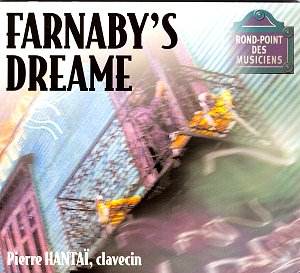Of all English composers
of keyboard music in the ‘Elizabethan
era’ - the decades around 1600 - Giles
Farnaby is one of the most obscure.
There is no reference to him in poems
of the time, nor was any tribute paid
to him by colleagues. None of his keyboard
works - 53 in total - were published
during his life. All but one have survived
only because Francis Tregian included
them in his collection of keyboard music
which is now known as the ‘Fitzwilliam
Virginal Book’.
The relative obscurity
of Farnaby is probably due to the fact
that he wasn’t a professional musician.
He was a joiner by trade, like his father.
He received musical training, though:
in 1592 he obtained the degree of bachelor
in music in Oxford, on the same day
John Bull received his doctorate. It
is possible, but not certain that Bull
was Farnaby’s teacher.
Farnaby never occupied
a position as musician. It seems that
he was active in this field, since he
was described as ‘musitian’, when he
was buried in 1640. A cousin of his
was joiner and ‘virginal builder’ and
it is thought that Farnaby has been
involved in building and repairing keyboard
instruments as well. Richard Marlow
explains the fact that almost all of
Farnaby's keyboard works were included
in the Fitzwilliam Virginal Book by
suggesting that during the time Francis
Tregian was imprisoned in London for
recusancy it was Giles Farnaby who maintained
his virginal. He might have brought
him some of his compositions as well.
Farnaby composed keyboard
music in almost all forms, like contrapuntal
Fantasias, dances and ‘character pieces’
(like ‘Giles Farnaby’s Dreame’ which
has given this CD its title). Of course
he also wrote variations on popular
tunes, many of which were also used
by other composers, like ‘Mal Sims’,
which is on the same melody as Sweelinck’s
‘Malle Symen’. And Farnaby is one of
many who made a keyboard transcription
of Dowland’s famous ‘Lachrymae Pavan’.
Farnaby may have been
very modest about his own composing
abilities, as he described himself as
"a sely sparrowe who presumeth
to chirpe in the presence of the melodious
Nightingall" (probably referring
to John Bull), he certainly composed
music with a character all of its own.
His music displays great imagination
and many pieces are quite virtuosic.
The brilliant variations on Wooddy-Cock,
an ancient Scottish tune, are a good
example. Here and elsewhere the relentless
repetition of the same motifs in the
left hand is electrifying. In a number
of pieces sequences of quavers are followed
by passages with semiquavers, followed
by demisemiquavers which bring the piece
or a section to a close, suggesting
an increase in tempo. Farnaby also seems
to have had a special liking of parallel
thirds, which regularly appear in his
keyboard works. His portrayal of ‘The
King’s Hunt’ is no less effective than
the more famous by John Bull. In some
of his Fantasias he shows how to work
toward a climax (e.g. No. 5).
The performance by
Pierre Hantaï is generally good,
but not entirely satisfying. He regularly
varies the tempo within a piece, whereas
I think this kind of music really needs
a very strict tempo. And some of the
lighter pieces are played a little to
heavily. The last work on this CD, ‘A
Toy’, should be much more playful than
it is here. I also think that some pieces
are played too slow.
But I am grateful that
this recording has been reissued, since
Farnaby’s music isn’t recorded often.
One of the attractions of this CD is
the use of two splendid historical instruments,
one of which – the Italian harpsichord
– belongs to the famous collection of
Kenneth Gilbert.
I would like also to
recommend another recording devoted
to Farnaby’s music, by the late Bradford
Tracey (on the Adagio label). That recording
contains mostly pieces which are not
on this CD, and is therefore a good
and very well-played addition to what
is offered by Pierre Hantaï.
Johan van Veen

